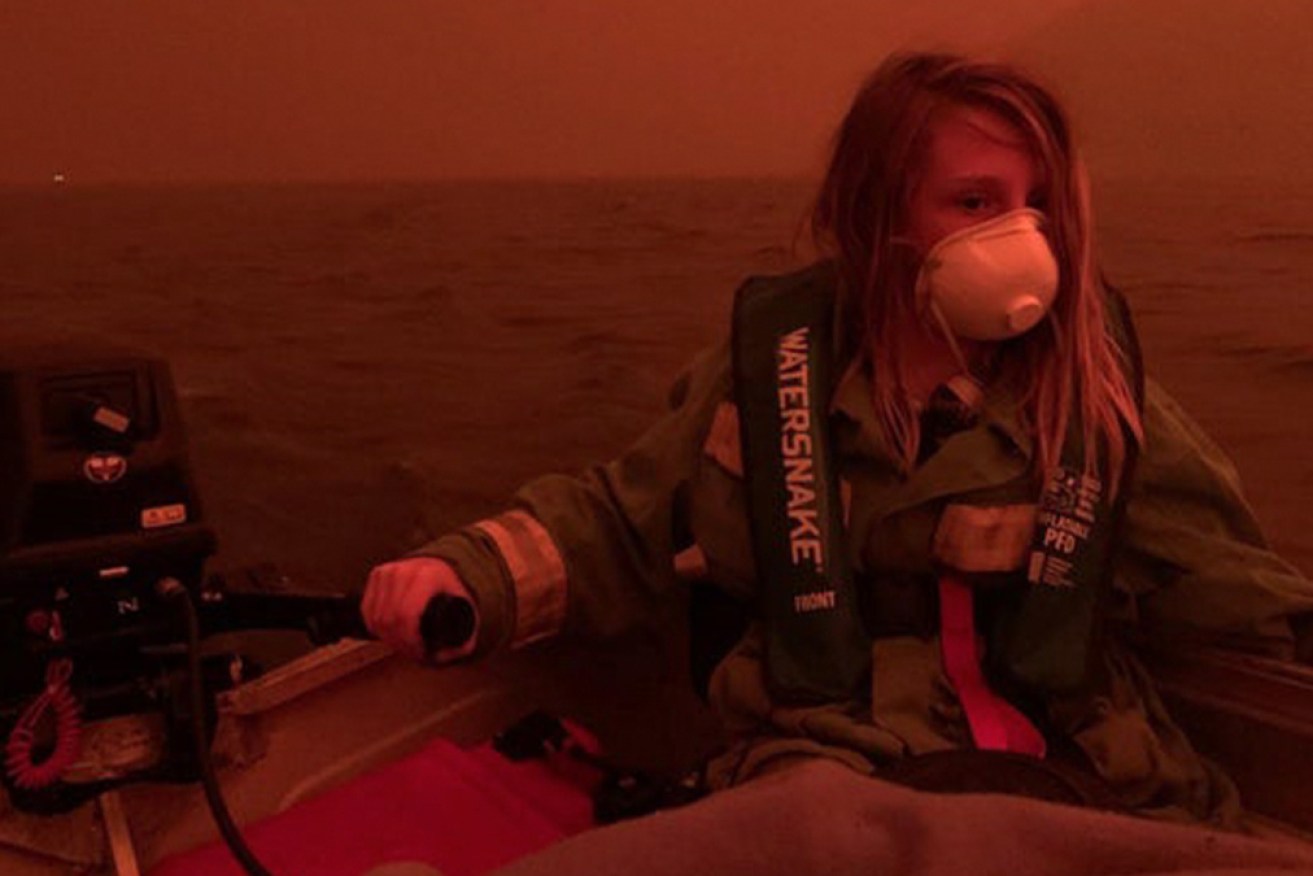Looking forward in Mallacoota, one year after the flames arrived

This image of Finn escaping the fires at Mallacoota became the face of the bushfire crisis. Photo: ABC News
The people of Mallacoota in Victoria’s east will gather on Wednesday morning not far from where – one a year ago – they huddled in fear against an eerie red backdrop.
Unlike last year, and most days that followed throughout 2020, there is much to cheers to this New Year’s Eve eve.
But there is no time yet to celebrate when there is still so much work to be done. And they worry the rest of the nation has moved on.
Locals want the plaque they will unveil to be a place of sober reflection – and an object that sparks conversations for years to come.
They want to talk about how to avoid a repeat of history.
It was just after 8am to the day last year that a bushfire – caused by a lightning strike three days earlier, and 40 kilometres north along the coast – brought a wall of flames towards the town.

Mallacoota beneath an unearthly red sky. Photo: ABC
In the hours that followed, more than 135 homes were destroyed and many others damaged.
Photographs and videos sent from scared locals and tourists to family and friends, and subsequently shared around the world, showed what was happening on the ground as a 10-kilometre fire front approached.
In a time before face masks were the daily norm for many Australians, images of a child in protective face gear steering a boat to safety caused us all to take a collective gasp.
Here was the reality faced by thousands of residents and holidaymakers who should have been preparing to wish each other a happy New Year: A blazing red sky and a choice between staying in Mallacoota with no idea if a ring of flames would wipe out the town, or get across the water.

Pictures of Finn, aged 11, were printed around Australia and the world. Photo: ABC
Allison Marion would later recall taking the photo of her son Finn as her family evacuated in the tinny.
“Both my boys are little legends. They were very calm,” Ms Marion told the ABC from where she sheltered days later.
“Finn drove the boat and my other son looked after the dog in the boat and [I am] very proud of both of them.
“We were lucky enough to be with a group of other people from Mallacoota and other families who assisted us.”
Navy ships were deployed to transport those most in need and to bring supplies to the area, which was cut off from roads.
By the start of 2020, families could breathe a sigh of relief.
The clean up was just beginning though – and to this day a full recovery is a long way off.
Every little bit has been helping.
Almost half of the population volunteers time to help the bushfire recovery in some way or other.
This is against the average volunteer participation rate in Australia of 19 per cent.

Mallacoota locals during the bushfire crisis in January.
Proclaiming its presence as The Hub is the Mallacoota District centre of Bushfire Recovery Victoria.
Soon after people returned from evacuation in January, the town voted to create a community-led recovery association, to build community resilience. This was incorporated as the Mallacoota and District Recovery Association (MADRA).
Not to be left out, the youth created an online hub to share positivity, which they call MAD Random Acts.
Tourists are playing a role in the recovery this summer, too.
Mallacoota is the last township in Victoria along the coast before the Princes Highway crosses into New South Wales.
Ordinarily its population of about 1100 grows to 8000 in peak seasons, particularly over Easter and Christmas.
The crowds have started returning already; Victorians have been drawn to rural areas this summer, to get away after COVID-19 lockdowns and do their bit for regional economies.
The Victorian Regional Travel Voucher Scheme for applications to register for a $200 rebate to spend on accommodation, attractions or tours crashed the day it was opened.
A disconcerting observation of arrivals in Mallacoota might be of properties up for sale, but the resilience of the community and the town’s vibrancy is evident on a walk around the main streets.
The seafood and steaks are a delight at the Mallacoota Bistro Hotel.
Everybody points the visitor to Lucy’s for the abalone that the region is known for.
The Mallacoota Arts Space housing 3MGB Community Radio is humming, and the powered sites full at the Mallacoota Foreshore.
Katie Symes, co-ordinator of the Mallacoota District of Bushfire Recovery Victoria, said the district was now “more visible to the world”.
“The Mallacoota and District community have now experienced an event that will define us and our sense of place together, forever. The lived experiences we shared … have become part of our narrative,” Ms Symes said.
Our stories of devastation and loss, but also of regeneration and strength, will serve the community well along the long road to recovery and healing.’’
Ms Symes said the pandemic had caused a “global pause”, a sense of stillness and time for reflection, “like we have not seen in a very long time”.
“Perhaps there is an opportunity for us all to listen more deeply to Mother Nature and to truly value what is most precious and endangered,” she said.
“Our natural environment and the sense of connection we share with it and to each other.
“It is my hope that visitors will continue to visit our region in support of recovery with understanding and respect, and by treading lightly with us and the natural environment, as they journey through this special little corner of the world.”








